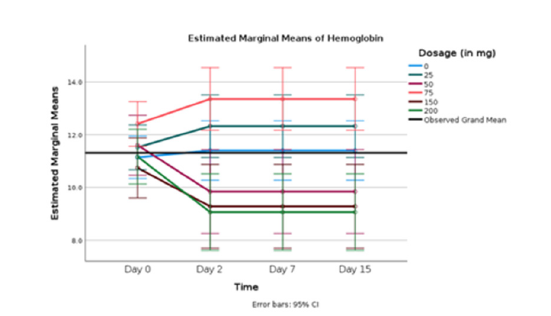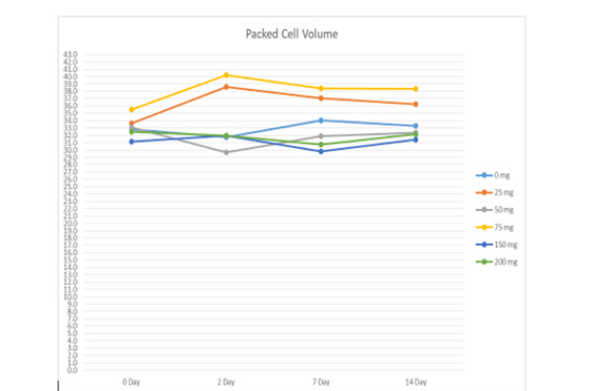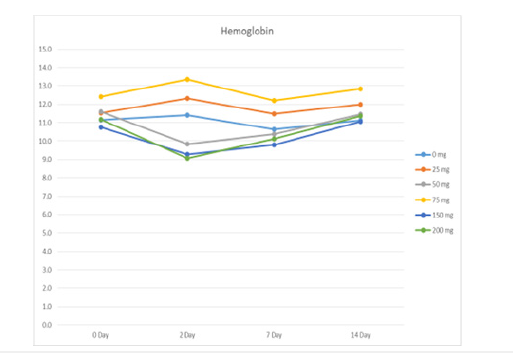- Submissions

Full Text
Approaches in Poultry, Dairy & Veterinary Sciences
Comparison of Different Injectable Cobalt Levels for Treatment to Increase Red Blood Parameters in Beef Calves
Bob B Sager* and Stuart L Pierce
Medicine Creek Bovine Health Solutions, USA
*Corresponding author: Bob B Sager, Medicine Creek Bovine Health Solutions, Consulting and Research, White Sulphur Springs, MT 59645, Lexington, Kentucky, USA
Submission: February 19, 2024;Published: March 01, 2024

ISSN: 2576-9162 Volume9 Issue4
Abstract
All ruminants require Cobalt (Co) in their diet for synthesis of vitamin B12. Cobalt, a trace mineral, which is utilized by gram negative anaerobic rumen microbes to synthesize vitamin B12. Vitamin B12 is an essential nutrient for carbohydrate metabolism and protein synthesis, for synthesis of plasma cells (antibody production) from B cells in the immune system, for production of red blood cells (RBC), and for normal nervous system function. This trial showed that RBC, packed cell volume, and hemoglobin were increased post treatment in this group of beef calves with a single injectable Co injection. This study used different dosages of a single subcutaneous injection of Co (cobalt) 25, 50, 75, 150, and 200mg/500lbs. To evaluate if Co would improve RBC, Hg (Hemoglobin), and PVC (Packed Cell Volume) in weaned beef calves. Of the different dosages used in this trial results showed that 75mg/500lbs. To be the most effective P<0.051. This study suggests that an injectable Co product could be used to increase RBC parameters in stressed beef calves and could be used as a treatment for anemia and support treatment for Anaplasmosis and other similar anemic problems in beef cattle.
Keywords:Cobalt (Co); Weaned beef calves; subcutaneous injectable cobalt; RBC parameters
Introduction
Available information on nutritional treatment for anemia in beef cattle is difficult to find. Historically the use of oral and parental Co treatment in both ruminant and humans has been completed with successful results.
More recently, cobalt has gained attention for performance- enhancement in human and equine athletes and was subsequently banned as a PED (Performance Enhancing Drug). As early as 1933, a very small dose of cobalt given to rats and pigs revealed an increase in red blood cell counts [1]. Historically, cobalt was used to treat certain types of anemia, which was achieved by oral administration of inorganic cobalt chloride. Adult doses of cobalt chloride were typically in the range of 40-140μg Co /kg body weight / day (in a 70kg adult, this corresponds to 9,800μg/day) [2].
In cattle, Chapman and Kidder studied the interaction of supplemental cobalt and molybdenum in growing cattle [1-6]. In trials, administered cobalt (8mg daily) resulted in higher blood hemoglobin and packed cell volumes in treated calves [1].
In the form of vitamin B12, cobalt plays a number of crucial roles in many biological functions. Co in a form (other than that in the corrin ring of vitamin B12) is involved with the enzyme, Lysine 2, 3 - aminomutase which is a SAM (S-Andenosylmethionine) enzyme that facilitates the conversion of the amino acid lysine to beta lysine. B-lysine is an amino acid produced by platelets and is directly antibacterial [7].
Cobalt is a factor in RBC production in ruminants and the anemia that is associated with Co deficiency occurs late in the development of the syndrome and is characterized as normocytic normochromic anemia. Cobalt deficiency in soils can decrease forage Co concentrations and therefore cause vitamin B12 deficiency in cattle. Cobalt deficiency results in the depression of the vitamin B12-containing enzyme 5-methyltetrahydrofolate homocysteine methyltransferase. This interference with the recycling of methionine has a marked influence on folate metabolism. In addition to potentially causing anemia through inefficient folate metabolism, the decreased activity of this methyltransferase could lead to deficiency of methionine; this is a possible reason for nitrogen retention and the decreased body growth and wool growth observed in sheep.
Erythropoiesis which takes approximately 5 days to complete in ruminants is stimulated by erythropoietin and occurs in the bone marrow parenchyma. Bovine erythrocytes have a relatively longlife span of 130-160 days [8]. Current knowledge of Co is with the cellular sensing of oxygen deficiency (hypoxia). Cobalt stabilizes the transcriptional activator Hypoxia-Inducible Factor (HIF) and thus mimics hypoxia and stimulates erythropoietin production [8]. Cobalt is accumulated primarily in the liver, kidney, pancreas and heart, with content in skeleton and skeletal muscle increasing with time after cobalt administration [8].
Recently weaned beef calves purchased and transported are stressed from both factors of weaning and transportation which critically alters and decreases the immune system response under the effect of cortisol. Bovine Respiratory Disease (BRD) and other diseases occur in stressed calves and are complicated with anemia secondary to the illness which prolongs recovery.
An injectable Co treatment administered at the same time as antibiotic treatment, vaccination, or at deworming, could result in a valuable treatment factor in improving health in stressed beef calves by increasing red blood cell parameters. Co treatment could provide for a more desired response to recovery, shorten recovery time, and improve health in stressed beef calves with deficient or marginal blood parameters. Co treatment could be considered an economically sound management treatment for stressed beef calves. With this knowledge the objective of this trial was to test the hypothesis that injectable Co given at a recommended dose could be a supplemental treatment for anemia in beef calves and also determine the recommended accurate dosage for beef calves to increase blood parameters of RBC, Hg, and PCV.
Methods and Materials
This comparison injectable cobalt study used a single subcutaneous injection of Co of a dosage of 25, 50, 75, 150, and 200mg administered to weaned beef calves with an average weight of 515lbs. To evaluate if Co would improve RBC (red blood cell) parameters and also establish a preferential treatment dosage. Forty- four weaned beef steers were purchased from a sales yard in central Kentucky and were chosen for the study. The calves were off of several farms of origin with similar genetics, similar weight and BCS (body condition score) and with similar nutritional and environmental backgrounds comingled in a large backgrounding lot before the trial started. All calves were kept in the same environment before the trial to reduce weaning and shipping stress factors that could influence the trial outcome.
At processing immediately after purchase all cattle received an oral drench Safeguard® dewormer, poured with DeLice®, vaccinated with Vista Once®, Ultrabac 7 plus Somnus®, and Nasalgen 3®. Thirty-four calves were randomly chosen during processing as the treatment group and were administered a single subcutaneous injectable chelated Co dosage (of 25, 50, 75, 150, or 200mg/500lbs.). Within this treatment trial five separate groups were administered different dosages with nine calves receiving the 25mg, 5 calves receiving the 50mg. dosage, 9 calves receiving the 75mg. dosage, 5 calves the 150mg. dosage, and 6 head the 200mg. dosage. The ten remaining calves were chosen as controls. The calves in the 150 and 200mg groups received a single dose divided into multiple injection sites under BQA guidelines.
Blood was aseptically drawn via jugular vein from all calves at processing (d 0) to determine baseline RBC, hemoglobin (Hg) and PCV (packed cell volume). Blood was again drawn on days 2, 7, and 15 to measure the same blood parameters to evaluate any change from the initial parameters. Blood analysis parameters were completed at Rood and Riddle Veterinary Hospital Laboratory, Lexington, Kentucky.
Discussion and Result
The goal of this research study was to determine if a single injectable (with a recommended dosage) cobalt treatment could increase blood parameters of PVC, Hg, and RBC in beef calves. If found effective, injectable Co could be used for support treatment for anemia in beef cattle or used as treatment support for stressed beef claves with underlining decreased blood parameters due to inflammation with BRD, Anaplasmosis, or similar disease issues.
Chart 1:Comparison of Different Dosages on RBC Changes Red blood cells 106/ml blood.

As seen in Chart 1, red blood cell counts in the control group were essentially unchanged from day 0 to day 15. Interestingly, the 25mg group had a 7% increase (9.3 to 10.0) in RBC values from day 0 to 15 and trending toward significance (P = 0.07) with no change in the 50mg, 150mg or 200mg groups. At 15 days, the 75mg treated group showed RBC of 10.3 (106/ul) versus the control group of 9.5 (p=0.04). This reflects an 8% increase RBC from day 0 to day 15 compared to no change in the controls. At d15, RBC is above the accepted reference range 4.9-10x106/ul.6
Statistical analysis of the trial showed Pairwise comparisons and were then conducted in order to further examine these effects. First, in regard to the effects of dosage, significant pairwise comparisons were found when comparing the effects of 75mg dosage with 50mg, 150mg, and 200mg dosages. Specifically, the effect of a 75mg dosage was associated with significantly increased hemoglobin as compared with 25mg, 50mg (P=0.023), 150mg, and 200mg. (P=< 0.023) Regarding the pairwise comparisons conducted with time, the means associated with time 1 were found to be significantly higher as compared with the following three time points. In all three pairwise comparisons, Mean Difference = .553, with P< .01 (Figure 1).
Figure 1:illustrates the estimated marginal means associated with these data on the basis of time as well as dosage, with 95% confidence intervals also shown.

Erythropoiesis which takes approximately 5 days is stimulated by erythropoietin and occurs in the bone marrow parenchyma thus explaining increased values of the treated group by day 15. Chart 2 summarizes the changes in packed cell volumes. The control group was essentially unchanged from day 0 to day 15. The biggest change again was the 75mg dosage group with a 7.3% increase (35.5 to 38.3) in PCV from day 0 to day 15 (P = 0.018).
Chart 2:Comparisons of PVC Changes PCV (packed cell volume) is represented as ml of cells in 100ml of blood.

In addition, the 25mg group had an increase in PCV compared to controls, 31.73 versus 38.56 and found to be significant (P =0.05). In Chart 3, cobalt treated calves Hg levels increased in the 25mg (4%), 75mg (4%) and the 150mg (3.6%) groups from day 0 to day 15 while there was no change in the control group. No statistical significance was observed. The hemoglobin value of 12.8g/dl as seen in the 75mg group on day 15 is above acceptable ranges (8.4- 12.2g/dl)6 showing statistical significance (P=0.023).
Chart 3:Comparisons of PVC Changes PCV (packed cell volume) is represented as ml of cells in 100ml of blood.

Conclusion
This study has shown that a single subcutaneous injection of Co can increase RBC, Hg, and PCV in weaned beef calves. Comparison of different dosages showed in this trial that a dosage of 75mg/500lbs. of a chelated Co was more effective in improving all three blood parameters than all other doses administered. Other dosages of treated calves showed increased RBC parameters however the 75mg group had the most consistent improvement. The use of a single injectable dose of Co could provide support for stressed calves with anemia caused by other problems such as Anaplasmosis and other RBC altering conditions and decrease recovery time and improve treatment results. Parenteral cobalt has potential to support and improve anemic conditions in beef cattle resulting in improvement and increased health of non-specific anemias of cattle in the future by increasing RBC, Hg, and PCV. By increasing these blood parameters, successful treatment may be an opportunity for stressed anemic cattle to recover by using a nutritional approach. Co treatment could be used in stressed calves to increase RBC and oxygen tissue capacity to improve overall health. In addition, cattle, affected by non-specific diseases causing anemia could benefit from the use of Co injectable treatment by promoting recovery of deficient blood parameters resulting in improved health and decreased recovery time.
The results of this study were promising, however additional research on the parenteral use of cobalt in beef cattle is warranted. Parenteral use of cobalt has potential to improve health in stressed anemic beef calves thereby support recovery of health in diseased beef calves.
References
- Chapman HL, Kidder RW (1963) Oral administration of molybdenum and cobalt to brahman-angus heifers. J An Science 22(4): 985-988.
- Finley BL, Monnot AD, Paustenbach DJ, Gaffney SH (2012) Derivation of a chronic oral reference dose for cobalt. Regulatory Toxicology and Pharmacology 64(3): 491-503.
- Finley BL, Unice Km, Kerger BD, Otani JM, Paustencach DJ, et al. (2013) 31-day study of cobalt chloride ingestion in human patients: pharmacokinetics and clinical effects. J Toxicol Environ Health A 76(21): 1210-1224.
- Gene Mayer (2017) Immunology-Chapter 1, Innate (Non-Specific) Immunity.
- Kobayashi M, Shimizu S (1999) Cobalt Proteins. Eur J Biochem 261(1): 1-9.
- Roland L, Drillich M, Iwersen M (2014) Hematology as a diagnostic tool in bovine medicine. Journal of Veterinary Diagnostic Investigation 26(5): 592-598.
- Sager RB, (2014) Cobalt Supplementation in Beef Calves, Thesis
- Simonsen LO, Harbak H, Bennekou P (2012) Cobalt metabolism and toxicity-a brief update. Sci Total Envoron 15(432): 210-215.
- https://www.sciencedirect.com/science/article/pii/S0021925818760420
© 2024 Bob B Sager. This is an open access article distributed under the terms of the Creative Commons Attribution License , which permits unrestricted use, distribution, and build upon your work non-commercially.
 a Creative Commons Attribution 4.0 International License. Based on a work at www.crimsonpublishers.com.
Best viewed in
a Creative Commons Attribution 4.0 International License. Based on a work at www.crimsonpublishers.com.
Best viewed in 







.jpg)






























 Editorial Board Registrations
Editorial Board Registrations Submit your Article
Submit your Article Refer a Friend
Refer a Friend Advertise With Us
Advertise With Us
.jpg)






.jpg)














.bmp)
.jpg)
.png)
.jpg)










.jpg)






.png)

.png)



.png)






